The following descriptions are meant as a reminder of the very basics of what we
do. For more information, or to request one of our in-depth education modules,
please reach out to us.
Home Inspection:
A home inspection is a non-invasive, visual examination of two or more of the
following components of a residential dwelling: mechanical, electrical, plumbing
and/or structural.
Pest Inspection:
This inspection identifies whether there is any visible evidence of
wood-destroying insects in your home, as well as any visible evidence of
previous treatment.
Radon Testing:
A test which identifies current radon levels in a home. Radon is a colorless, odorless
gas emitted into the air by the radioactive element, radium, as it breaks down in
soil, rock, and water. Typically, radon enters buildings through small cracks or
openings in the foundation.
Sewer Camera:
A sewer scope is an inspection of the lateral sewer line leading from the house
at/near the foundation which then connects to a public tap or a septic tank.
Sewer-scoping the line can reveal blockages, damage to the pipe system, and
other issues.
Drone Footage:
Typically, the most important part of a roof inspection is from the underside (in the
attic area) which is why it is important for all areas to be made accessible to the
inspector. However, most often there are areas with limited access/visibility. In
these instances, it is important for the inspector to be able to see as much of the
exterior surface as possible, and walking on the roof is usually not suggested due
to risk of damaging surface materials. Other reasons for not walking on a roof
would be dangerous weather conditions, the pitch of the roof, the age of
materials including underlying wood members. These conditions run the risk of
not only damaging the roofing materials, but risks of the inspector falling off or
into the roof. When any of these conditions exist, a drone is the most effective
way of getting the best possible look at roof surfaces.
Well Flow Test:
This test is conducted to determine whether there is a sustainable flow of water
from a private well.
Water Quality Sampling:
1. Bacteriological Sampling: Water Samples are collected and sent to a lab which analyzes
those samples to determine the presence of bacteria in the water.
2. Nitrate/Nitrite & Lead Sampling: Samples are collected and sent to a lab to examine if nitrates, nitrites, or lead
exist in the water.
Septic Dye Testing:
This test uses a brightly colored, non-toxic tracing dye to help ensure that
wastewater is correctly routing into/through the septic system. A dye test can
help identify if a septic system discharges untreated sewage to the surface of the
ground or into nearby waterways.
Mold Samples:
Air samples can be used to gather data about mold spores present in the interior
of a house. These samples are taken by using a pump that forces air through a
collection device which catches mold spores. Swab tests are also available.
These samples are then sent to a laboratory to be analyzed.
Note:
We also perform other environmental services (such as asbestos sampling) upon
request.
